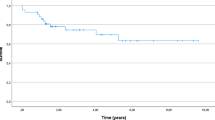Abstract
Purpose
This study aimed to analyse functional outcome and quality of life (QoL) after surgical treatment of periprosthetic femoral fractures (PPF) following total hip arthroplasty (THA).
Methods
This retrospective study assessed 67 patients from 2005 to 2012. Epidemiologic data, surgical details, comorbidities, deaths and postoperative complications were recorded. Functional assessment included Harris Hip Score (HHS) and range of motion (ROM); QoL was assessed using the Short-Form Health Survey of 36 questions (SF-36) and Western Ontario and McMaster Universities Osteoarthritis Index (WOMAC) scores.
Results
Mean HHS was 69 ± 21 and ROM 96° ± 17°. Mean SF-36 and WOMAC scores revealed 44 ± 7.2 and 18.9 ± 19.6, respectively. The complication rate was 25.4 %; 23.7 % of patients died. Analysis revealed no statistical influence on final outcome as a function of fracture type or treatment strategy. Comorbidities seem to influence functional outcome.
Conclusion
PPF following THA are accompanied by a perceptible decline of function and remarkably high complication rates. In contrast to fracture classification and treatment type, American Society of Anesthesiologists (ASA) score predicts outcome.





Similar content being viewed by others
References
Sadoghi P, Liebensteiner M, Agreiter M, Leithner A, Bohler N, Labek G (2013) Revision surgery after total joint arthroplasty: a complication-based analysis using worldwide arthroplasty registers. J Arthroplasty 28(8):1329–1332. doi:10.1016/j.arth.2013.01.012
Young SW, Pandit S, Munro JT, Pitto RP (2007) Periprosthetic femoral fractures after total hip arthroplasty. ANZ J Surg 77(6):424–428. doi:10.1111/j.1445-2197.2007.04087.x
Della Rocca GJ, Leung KS, Pape HC (2011) Periprosthetic fractures: epidemiology and future projections. J Orthop Trauma 25(Suppl 2):S66–S70. doi:10.1097/BOT.0b013e31821b8c28
Moreta J, Aguirre U, de Ugarte OS, Jauregui I, Mozos JL (2014) Functional and radiological outcome of periprosthetic femoral fractures after hip arthroplasty. Injury. doi:10.1016/j.injury.2014.07.013
Singh JA, Jensen MR, Harmsen SW, Lewallen DG (2013) Are gender, comorbidity, and obesity risk factors for postoperative periprosthetic fractures after primary total hip arthroplasty? J Arthroplasty 28(1):126–131. doi:10.1016/j.arth.2012.03.010, e121-122
Duncan CP, Haddad FS (2014) The Unified Classification System (UCS): improving our understanding of periprosthetic fractures. Bone Joint J 96-b(6):713–716
Duncan CP, Masri BA (1995) Fractures of the femur after hip replacement. Instr Course Lect 44:293–304
Parvizi J, Rapuri VR, Purtill JJ, Sharkey PF, Rothman RH, Hozack WJ (2004) Treatment protocol for proximal femoral periprosthetic fractures. J Bone Joint Surg Am 86-A(Suppl 2):8–16
Parvizi J, Vegari DN (2011) Periprosthetic proximal femur fractures: current concepts. J Orthop Trauma 25(Suppl 2):S77–S81. doi:10.1097/BOT.0b013e31821b8c3b
Zuurmond RG, van Wijhe W, van Raay JJ, Bulstra SK (2010) High incidence of complications and poor clinical outcome in the operative treatment of periprosthetic femoral fractures: an analysis of 71 cases. Injury 41(6):629–633. doi:10.1016/j.injury.2010.01.102
Saklad M (1941) Grading of patients for surgical procedures. Anesthesiology 2:281–284
Charlson M, Szatrowski TP, Peterson J, Gold J (1994) Validation of a combined comorbidity index. J Clin Epidemiol 47(11):1245–1251
Tarlov AR, Ware JE Jr, Greenfield S, Nelson EC, Perrin E, Zubkoff M (1989) The Medical Outcomes Study. An application of methods for monitoring the results of medical care. JAMA 262(7):925–930
Stucki G, Meier D, Stucki S, Michel BA, Tyndall AG, Dick W, Theiler R (1996) Evaluation of a German version of WOMAC (Western Ontario and McMaster Universities) arthrosis index. Z Rheumatol 55(1):40–49
Harris WH (1969) Traumatic arthritis of the hip after dislocation and acetabular fractures: treatment by mold arthroplasty. An end-result study using a new method of result evaluation. J Bone Joint Surg Am 51(4):737–755
Marchetti P, Binazzi R, Vaccari V, Girolami M, Morici F, Impallomeni C, Commessatti M, Silvello L (2005) Long-term results with cementless Fitek (or Fitmore) cups. J Arthroplasty 20(6):730–737. doi:10.1016/j.arth.2004.11.019
Lindahl H, Garellick G, Regner H, Herberts P, Malchau H (2006) Three hundred and twenty-one periprosthetic femoral fractures. J Bone Joint Surg Am 88(6):1215–1222. doi:10.2106/JBJS.E.00457
Lindahl H, Malchau H, Herberts P, Garellick G (2005) Periprosthetic femoral fractures classification and demographics of 1049 periprosthetic femoral fractures from the Swedish National Hip Arthroplasty Register. J Arthroplasty 20(7):857–865. doi:10.1016/j.arth.2005.02.001
Zampelis V, Ornstein E, Franzen H, Atroshi I (2014) A simple visual analog scale for pain is as responsive as the WOMAC, the SF-36, and the EQ-5D in measuring outcomes of revision hip arthroplasty. Acta Orthop 85(2):128–132. doi:10.3109/17453674.2014.887951
Kurth BM, Ellert U (2002) The SF-36 questionnaire and its usefulness in population studies: results of the German Health Interview and Examination Survey 1998. Soz Praventivmed 47(4):266–277
Mariconda M, Galasso O, Costa GG, Recano P, Cerbasi S (2011) Quality of life and functionality after total hip arthroplasty: a long-term follow-up study. BMC Musculoskelet Disord 12:222. doi:10.1186/1471-2474-12-222
Bravo LE, Garcia LS, Collazos PA (2014) Cancer survival in Cali, Colombia: a population-based study, 1995–2004. Colomb Med (Cali, Colomb) 45(3):110–116
Beaulieu ML, Lamontagne M, Beaule PE (2010) Lower limb biomechanics during gait do not return to normal following total hip arthroplasty. Gait Posture 32(2):269–273. doi:10.1016/j.gaitpost.2010.05.007
Beals RK, Tower SS (1996) Periprosthetic fractures of the femur. An analysis of 93 fractures. Clin Orthop Relat Res 327:238–246
Holder N, Papp S, Gofton W, Beaule PE (2014) Outcomes following surgical treatment of periprosthetic femur fractures: a single centre series. Can J Surg 57(3):209–213
Compliance with Ethical Standards
For this type of study formal consent is not required.
Conflicts of interest
None.
Author information
Authors and Affiliations
Corresponding author
Rights and permissions
About this article
Cite this article
Märdian, S., Schaser, KD., Gruner, J. et al. Adequate surgical treatment of periprosthetic femoral fractures following hip arthroplasty does not correlate with functional outcome and quality of life. International Orthopaedics (SICOT) 39, 1701–1708 (2015). https://doi.org/10.1007/s00264-015-2673-2
Received:
Accepted:
Published:
Issue Date:
DOI: https://doi.org/10.1007/s00264-015-2673-2




